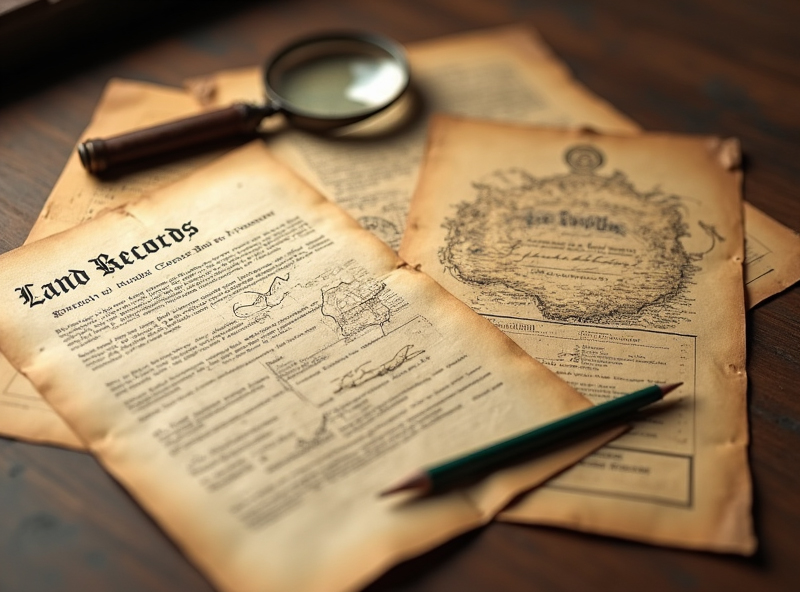Most of the time, when researching family history, many of us focus solely on birth, marriage, and death records. We tend to overlook the value contained in land records and deeds. These show where your ancestors lived, owned or worked, and sometimes even what they did and whom they knew. If your ancestors farmed, were landlords or renters, records like these help fill in gaps and further provide family connections to imagine how they lived.
This guide will take you through the very basics of using land records and deeds in your genealogy research, so you can start uncovering your family’s ties to the places they called home.
Why Land Records Are Useful in Genealogy
Land records give you more than just a place. You’ll find that you can see how property was passed from one generation to the next and even how spouses or children are named, sometimes unfortunately unexpectedly unknowing discovery of family members.
Imagine what that could mean for your family land that has been in your family for generations. Or perhaps discover your great-great-grandfather bought land shortly after immigrating, possibly indicating how quickly he was able to get his feet on the ground.
Land records add layers to your family’s story-you’ll not only know where they lived, you’ll see into the social and economic life of your family’s history.
Types of Land Records and What They Show
There are a few major types of land records that genealogists find particularly useful:
- Deeds: These are the most prolific land records. A deed is a conveyance, displaying property transferred from one individual to another. Deeds generally contain the names of the buyers and sellers involved; they contain information regarding the property, such as its description, and sometimes even the relationship between individuals. For instance, a deed might identify “John Smith, son of William Smith,” and that would prove an excellent family relationship.
- Land grants and patents: These are documents that show land granted by a government or other authority. Many of your ancestors received land through grants, especially in newly settled areas. A land grant might show where your ancestor first settled in an area, and when. That is a big clue to migration patterns.
- Warrants and surveys: A warrant is a permit to survey land, usually part of a grant of land. The survey records include boundaries and features of the land, and knowing these dimensions and locales can help you understand exactly how large or small the tract was and precisely where it lay. Surveys also may include references to neighbors, which can bring you to other family ties or communities where your ancestors settled.
- Tax records: Tax records aren’t land records strictly speaking, but they do contain valuable information. Tax rolls may identify landowners and, being taken periodically, you might follow the progression of where an ancestor lived or owned property.

Land Records and Deeds: Where to Search
Land records and deeds are not always readily available, but you might begin searching here:
County Clerk or Recorder's Office
Most property records are maintained at the county level. These can often be found in the county where the property is located. These offices will typically house the county clerk or recorder who houses the deeds and other land transactions as well as other properties. Most of them go back as far as the 18th or even 17th century, depending on the area. Some counties have digitized these records online, but you will most likely need to make a personal visit or request them by mail.
State Archives
State archives generally contain older land records of a given age, particularly those by the state or colonial government. This archive might be your best point of contact if you are researching ancestors who lived in the 1600s or 1700s. In most cases, these state archives have deposited their collections online, and some have even put their collections on the internet in digitized form for you to access at home. Great potential source.
National Archives
The National Archives in the United States contains federal land records, which are mostly for government-issued land patents and grants, especially for territories and newly settled areas. If your ancestors obtained land in a federal territory or state where land was distributed by the government, then you will find these records useful. The Bureau of Land Management has provided public access to an online searchable database for federal land patents called General Land Office.
Online Genealogy Databases
Land and property record collections of such places can also be found at Ancestry.com and FamilySearch.org. Access is easier as you can search a specific record by name, location, or date. Some records are not digitized, so if you do not find the required information, look it up in local or state archives.
Local Libraries and Historical Societies
Not uncommonly, local historical societies and public libraries carry land records collections for rural or small towns. They might also hold maps, tax rolls, or local histories that can yield further information about the land and the people who used to occupy it.
Deciphering a Deed: What to Search for
Deeds are often intimidating due to their use of arcane legal terminology, but there are a few things you should be on the lookout for:
- Grantor and grantee: The grantor is the vendor, while the grantee is the purchaser. Knowing who sold and bought the land can help you trace ownership and perhaps family connections.
- Property description: Most deeds contain a description of the property, usually by landmarks or measurements. That might help you understand where the land is and how big it might be, and you might even be able to mark down a spot on an old map.
- Witnesses: Deeds mostly have witnesses’ signatures. The witnesses might be family members or next-door neighbors. At times, witness names may give you a hint of closer connections between family members or a strong hold on the community.
- Conditions or restrictions: Some conditions accompany deeds while transferring property. For example, the land is passed on with a condition that it should remain in the family, among other conditions. Such information will give you an insight into the expectations of the family members or legal restrictions during the time.

How to Use Land Records in Your Genealogy Research
Land records are a bit like the breadcrumbs left by an earlier pilgrim. They can take you a long way, but sometimes they get lost or confusing. Here are some practical ways to follow these breadcrumbs and integrate them into your research:
- Follow the movement and migration: If you notice property ownership being sold and purchased in multiple counties or even states, this might be an indication of a migration route. Families traveled west during the 1800s, selling their property in one location and buying more land in another.
- Link family members: Land records at times list family members, especially in deeds involving inheritances or transfers among families. If you encounter a deed listing children, siblings, or other relatives, that might help connect family members.
- Neighbors and community: Land records often refer to neighbors or adjacent properties. If your ancestors had close neighbors who were family friends or even family members, a find in these records of their names might point you toward other family members or community networks.
- Discover what an ancestor’s financial situation was: The number of land holdings and their values can say much about an ancestor’s financial situation. An individual who had a great many large landholdings likely was more affluent, while a family that sold land often may have struggled financially.
Tips for Using Land Records
Land records will sometimes be difficult to use, but the following can make the task easier:
- Familiarize yourself with legal terminology: Learn such basic terms as “grantor,” “grantee,” “warranty deed,” and “quitclaim deed.” This will help you understand the language of the records.
- Read for boundary clues: Often in older deeds, the boundaries were described with reference to natural features or neighborly landmarks. Look to learn the geography of the area to get a mental image of where the land might have been.
- Old handwriting will try your patience: Hundreds of years of land record history, and sometimes writing is nearly illegible. Take your time and look for transcriptions, or use local archives to help you decipher.
Land records and deeds are just fine for genealogical research to depict where and how your ancestors lived, and while you are going through these records, you can trace who owned this property, family relationships, and insight into the home lives of those people who came before you.
Whether your ancestors had a small plot or thousands of acres, that land is part of their story. Land records allow you to walk in those steps: to see the places that were important to them and to discover the ties that bound them to those locations. So, next time you’re building out your family tree, don’t overlook that the land records may hold the key to your family’s hidden history.
Genealogy Quarry has a material connection with Ancestry.com, a third-party service provider. We are compensated by Ancestry.com through commissions when users engage with the search forms on our site (e.g., https://genealogyquarry.com/family-tree/) and subsequently purchase a trial or subscription from Ancestry.com. The search forms presented on our site are advertisements that direct users to Ancestry.com. While we strive to provide valuable resources and information to our visitors, please note that we are compensated by Ancestry.com when users purchase their services through these search forms. All opinions and content expressed on Genealogy Quarry are our own. We disclose this material connection in accordance with applicable guidelines to maintain transparency with our users.
